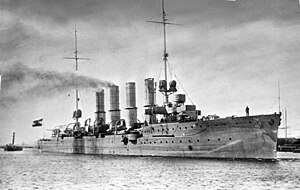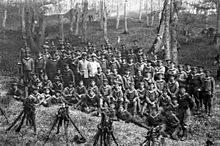SMS Breslau
 SMS Breslau in 1912
| |
| History | |
|---|---|
| Name | Breslau |
| Namesake | City of Breslau (Now part of Poland as Wrocław) |
| Builder | A.G. Vulcan |
| Laid down | 1910 |
| Launched | 16 May 1911 |
| Commissioned | 20 August 1912 |
| Fate | Transferred to the Ottoman Empire 16 August 1914 |
| Name | Midilli |
| Namesake | Island of Midilli |
| Acquired | 16 August 1914 |
| Fate | Mined & sunk off Imbros, 20 January 1918 |
| General characteristics | |
| Class and type | Magdeburg-class cruiser |
| Displacement |
|
| Length | 138.7 m (455 ft 1 in) |
| Beam | 13.5 m (44 ft 3 in) |
| Draft | 4.4 m (14 ft 5 in) |
| Installed power |
|
| Propulsion |
|
| Speed | 27.5 knots (50.9 km/h; 31.6 mph) |
| Range | 5,820 nmi (10,780 km; 6,700 mi) at 12 knots (22 km/h; 14 mph) |
| Complement |
|
| Armament |
|
| Armor |
|
SMS Breslau was a
Midilli was active in laying
Design
Breslau was 138.7 meters (455 ft)
The ship was armed with a
Service history

Breslau was ordered under the contract name "
Following her commissioning, Breslau was attached to the German
World War I
At the outbreak of
On 8 August, Goeben and Breslau met the collier off the island of
Ottoman service

1914
On the evening of 27 October 1914, Midilli and the rest of the Ottoman fleet left the
In early November 1914, while Midilli was operating in the eastern Black Sea and covering Ottoman transports, she was detached to shell the Russian port of
A month later, on 23 December, Midilli sortied to rendezvous with Yavûz Sultân Selîm off Sinope, and in the darkness the following morning she encountered the Russian transport Oleg, which was intended to be sunk as a blockship in Zonguldak. Midilli quickly sank Oleg but was forced to turn away after spotting Rostislav. She then encountered another blockship, Athos, and forced her crew to scuttle the ship. She then briefly engaged Russian destroyers before moving ahead of the Russian fleet to monitor their progress. Ottoman coastal guns forced the remaining blockships to scuttle in deep water.[21]
1915

Midilli conducted a series of sorties against the Russians in early 1915, including an operation in concert with the cruiser Hamidiye in January, during which they inadvertently came into contact with the Black Sea Fleet. Midilli scored a hit on the battleship Evstafi's main battery turret before the Ottoman ships withdrew.[22]
On 3 April, the Ottoman fleet sortied to attack Russian transports off
Midilli struck a mine on 18 July as she sailed from Constantinople to escort a merchant ship through the minefields defending the capital. The explosion under No. 4
1916
The ship did not return to service until February 1916, and the opportunity was taken to replace two of her 10.5 cm guns with 15 cm pieces. On 27 February, she was used to quickly transport 71 officers and men of a machine-gun company and a significant stock of supplies and munitions to Trebizond, which was then under heavy pressure from the Russian army. While en route on the night of the 28th, she encountered the Russian destroyers Pronzitelni and Bespokoiny. Midilli evaded the Russians and reached Trebizond. On 2 March, she attempted to attack a pair of destroyers north of Zonguldak, but she was unable to catch them. The ship then returned to the Bosporus. On 11 March, Midilli made another run, this time carrying 211 soldiers and twelve barrels of fuel and lubricating oil, which were successfully landed on the 13th. She then stopped in Samsun, where she picked up 30 t (30 long tons; 33 short tons) of flour, one ton of maize, and 30 tons of coal, before returning to the Bosporus.[28][b]
A third supply operation followed on 3 April, when the ship brought 107 men, 5,000 rifles, and 794 cases of ammunition to Trebizond. After making the delivery, the ship met the
In July, Midilli and Yavûz Sultân Selîm sortied to support the Ottoman counterattack at Trebizond, which broke the Russian lines and advanced some 20 km (12 mi). Midilli sank a pair of Russian ships off Sochi on 4 July and destroyed another that had been torpedoed the previous day. She then rejoined Yavûz Sultân Selîm for the return to the Bosporus, during which the two ships evaded strong Russian forces attempting to intercept them. Later that month, on 21 July, Midilli attempted to lay a minefield off Novorossisk, but Russian wireless interception allowed the dreadnought Imperatritsa Mariya and several destroyers to leave port and attempt to cut Midilli off from the Bosporus. The two ships encountered each other at 13:05, and Midilli quickly turned back south. Her stern 15 cm gun kept Russian destroyers at bay, but the ship only slowly drew out of range of Imperatritsa Mariya's heavy guns. Several near misses rained shell splinters on the deck and wounded several men. Heavy use of smoke screens and a rain squall allowed Midilli to break contact with her Russian pursuers, and she reached the Bosporus early the following morning. By the end of 1916, a severe coal shortage prevented Midilli and Yavûz Sultân Selîm from conducting offensive operations.[31]
1917–1918
In May 1917, Midilli laid a minefield off the mouth of the
On 20 January 1918, Midilli and Yavûz Sultân Selîm left the Dardanelles under the command of Vice Admiral
Notes
Footnotes
- ^ According to Hildebrand, Röhr, & Steinmetz, Breslau was built with only three funnels, with the fourth added after trials.[2] Gröner does not support this, with a line-drawing showing of the ship as built, with four funnels,[3] nor is it mentioned in Campbell & Sieche.[4]
- ^ Halpern is probably using German sources for this period, but the Turkish sources used by Langensiepen & Güleryüz provide a slightly different account. They refer to carrying troops to Trebizond and oil to Sinope on 27 February with no mention of any encounter with Russian destroyers. Furthermore, "A planned expedition along the Caucasus coast by Midilli is abandoned due to bad weather and the cruiser returns to base on 2 March."[29]
- ^ Langensiepen & Güleryüz also give a different account of this affair. They date the resupply mission to 18 April and that T.233 was heavily damaged, but survived. Midilli then sank the sailing ship Nikolay by herself. She encountered the Russian dreadnought on 19 April while returning from this mission.[29]
- ^ Langensiepen & Güleryüz date the minelaying to 23 June and the encounter with Svobodnaya Rossiya to 25 June.[33]
- ^ Langensiepen & Güleryüz only describe an unsuccessful search for a pair of Russian destroyers that had destroyed a Turkish convoy on 31 October and make no mention of an attempted Russian interception.[35]
Citations
- ^ Gröner, pp. 107–108.
- ^ a b Hildebrand, Röhr, & Steinmetz, pp. 139–142.
- ^ Gröner, p. 108.
- ^ Campbell & Sieche, p. 159.
- ^ Campbell & Sieche, pp. 140, 159.
- ^ a b c Gröner, p. 107.
- ^ Hildebrand, Röhr, & Steinmetz, p. 139.
- ^ Halpern, p. 15.
- ^ Zabecki, p. 7.
- ^ Halpern, pp. 51–52.
- ^ Bennett, pp. 33–34.
- ^ Halpern, p. 56.
- ^ Halpern, p. 56–58, 63.
- ^ Halpern, p. 63.
- ^ a b Langensiepen & Güleryüz, p. 45.
- ^ Nekrasov, p. 25.
- ^ Halpern, p. 64.
- ^ Halpern, p. 224.
- ^ McLaughlin, pp. 123–133.
- ^ Langensiepen & Güleryüz, p. 46.
- ^ Halpern, p. 228.
- ^ Halpern, pp. 228–229.
- ^ Halpern, p. 231.
- ^ Herwig, p. 171.
- ^ Langensiepen & Güleryüz, p. 48.
- ^ Nekrasov, pp. 59–60.
- ^ Langensiepen & Güleryüz, p. 49.
- ^ Halpern, pp. 241–242.
- ^ a b c Langensiepen & Güleryüz, p. 50.
- ^ Halpern, pp. 242–243.
- ^ Halpern, pp. 245–248.
- ^ Halpern, p. 253.
- ^ Langensiepen & Güleryüz, p. 52.
- ^ Halpern, p. 254.
- ^ Langensiepen & Güleryüz, p. 53.
- ^ Halpern, p. 255.
- ^ Buxton, pp. 36–37.
- ^ Hownam-Meek, et al., p. 95.
- ^ Campbell & Sieche, p. 152.
- ^ Langensiepen & Güleryüz, p. 32.
References
- ISBN 978-1-84415-300-8.
- Buxton, Ian (2008). Big Gun Monitors: Design, Construction and Operations 1914–1945 (2nd, revised and expanded ed.). Annapolis: Naval Institute Press. ISBN 978-1-59114-045-0.
- Campbell, N. J. M. & Sieche, Erwin (1986). "Germany". In Gardiner, Robert & Gray, Randal (eds.). Conway's All the World's Fighting Ships 1906–1921. London: Conway Maritime Press. pp. 134–189. ISBN 978-0-85177-245-5.
- ISBN 978-0-87021-790-6.
- Halpern, Paul G. (1995). A Naval History of World War I. Annapolis: Naval Institute Press. ISBN 978-1-55750-352-7.
- Herwig, Holger (1980). "Luxury" Fleet: The Imperial German Navy 1888–1918. Amherst: Humanity Books. ISBN 978-1-57392-286-9.
- Hildebrand, Hans H.; Röhr, Albert & Steinmetz, Hans-Otto (1993). Die Deutschen Kriegsschiffe: Biographien – ein Spiegel der Marinegeschichte von 1815 bis zur Gegenwart [The German Warships: Biographies − A Reflection of Naval History from 1815 to the Present] (in German). Vol. 2. Ratingen: Mundus Verlag. ISBN 978-3-8364-9743-5.
- Langensiepen, Bernd & Güleryüz, Ahmet (1995). The Ottoman Steam Navy 1828–1923. London: Conway Maritime Press. ISBN 978-0-85177-610-1.
- McLaughlin, Stephen (2001). "Predreadnoughts vs a Dreadnought: The Action off Cape Sarych, 18 November 1914". In Preston, Antony (ed.). Warship 2001–2002. London: Conway Maritime Press. pp. 117–40. ISBN 0-85177-901-8.
- Hownam-Meek, R. S. S.; et al. (2000). "Question 3/99: The Loss of the German Light Cruiser Breslau". Warship International. XXXVII (1). Toledo: International Naval Research Organization: 92–95. ISSN 0043-0374.
- Nekrasov, George (1992). North of Gallipoli: The Black Sea Fleet at War 1914–1917. East European Monographs. Vol. CCCXLIII. Boulder: East European Monographs. ISBN 978-0-88033-240-8.
- Zabecki, David T. (1995). Dönitz, A Defense. Bennington: World War II Historical Society. ISBN 978-1-57638-042-0.
Further reading
- Dodson, Aidan; Cant, Serena (2020). Spoils of War: The Fate of Enemy Fleets after the Two World Wars. Barnsley: Seaforth Publishing. ISBN 978-1-5267-4198-1.
- ISBN 978-1-68247-745-8.
External links
- Midilli, in the Turkey in First World War web site.

